As experienced professionals in the rendering industry, we understand the importance of accurate calculations for a successful project. Whether you're working on a small DIY task or a large-scale renovation, a render calculator can save you time, money, and effort.
In the UK, weather conditions and building regulations can influence the type of render used. A UK-specific render calculator takes these factors into account, ensuring your project complies with local standards. We recommend using these calculators for projects within the UK to ensure accuracy and efficiency.
Sand and cement render is a traditional and widely-used option for many projects. To use a sand and cement render calculator, you need to input the surface area to be rendered, the desired thickness, and the mix ratio. Typically, a mix ratio of 6 parts sand, 1 part cement, and 1 part lime is used.
Here's a breakdown of the different render calculators you'll find in the UK:
This is the most basic type, allowing you to input the wall dimensions and desired render thickness to estimate the total amount of sand and cement required.

Similar to the sand and cement calculator, this tool helps estimate the amount of monocouche render, a one-coat render system gaining popularity for its ease of application.

Silicone render, known for its flexibility and weather resistance, has its own calculator variant. This helps you determine the quantity of silicone render needed for the project.

This is a general term for calculators that estimate the amount of render required for walls, often allowing you to specify the desired render type for a more precise calculation.

There are several advantages to using a render calculator:
Pro Tip: Remember, render calculator results are estimates. Always factor in a slight buffer (around 5-10%) to account for material wastage during application.
In our years working across the UK, we've noticed that regional factors can influence rendering calculations:
While render calculators are invaluable tools, they're not a substitute for experience and judgment. We've encountered numerous situations where our years of hands-on experience have been crucial in fine-tuning calculations:
A calculator can't tell you about the condition of the underlying wall. We always perform a thorough inspection before finalizing our material estimates.
In areas prone to harsh weather, we might recommend a thicker render application, which would affect the calculator results.
No two jobs are identical. Our experience helps us adjust calculations on the fly when we encounter unforeseen issues.
In our many years in the rendering trade, we've seen the industry evolve dramatically. But remember, they're just that – a starting point. Combine the precision of render calculators with the irreplaceable knowledge that comes from years on the job, and you'll be set up for rendering success.
Whether you're using a basic sand and cement render calculator or a specialized tool for modern products like K Rend or monocouche, these calculators are your allies in achieving professional, high-quality renders.
Render calculators provide a good estimate, but they aren't perfect. Factors like surface unevenness and wastage during application can affect material usage. We recommend adding a buffer of 5-10% to your estimated quantities to account for this.
There are many options available! Look for a calculator specific to your chosen render type (e.g., sand and cement, K-Rend) for the best accuracy. Many render material suppliers in the UK offer calculators on their websites.
Most calculators require basic information like wall dimensions (length, width, height) and desired render thickness. Some might ask for additional details like the type of wall or specific product details.
This can vary. Some calculators default to metric (meters), while others use imperial (feet, inches). Check the calculator's settings to ensure you're using the units you're comfortable with.
If you can't find a calculator for your chosen render, a general "wall render calculator" might still be helpful. However, contacting the render material supplier directly is your best bet for an accurate estimate. They might have their own formula or guide to share.
Remember, render calculators are for estimation purposes. For complex projects, it's always wise to consult with a professional renderer who can assess the specific requirements and provide a more tailored material estimation.